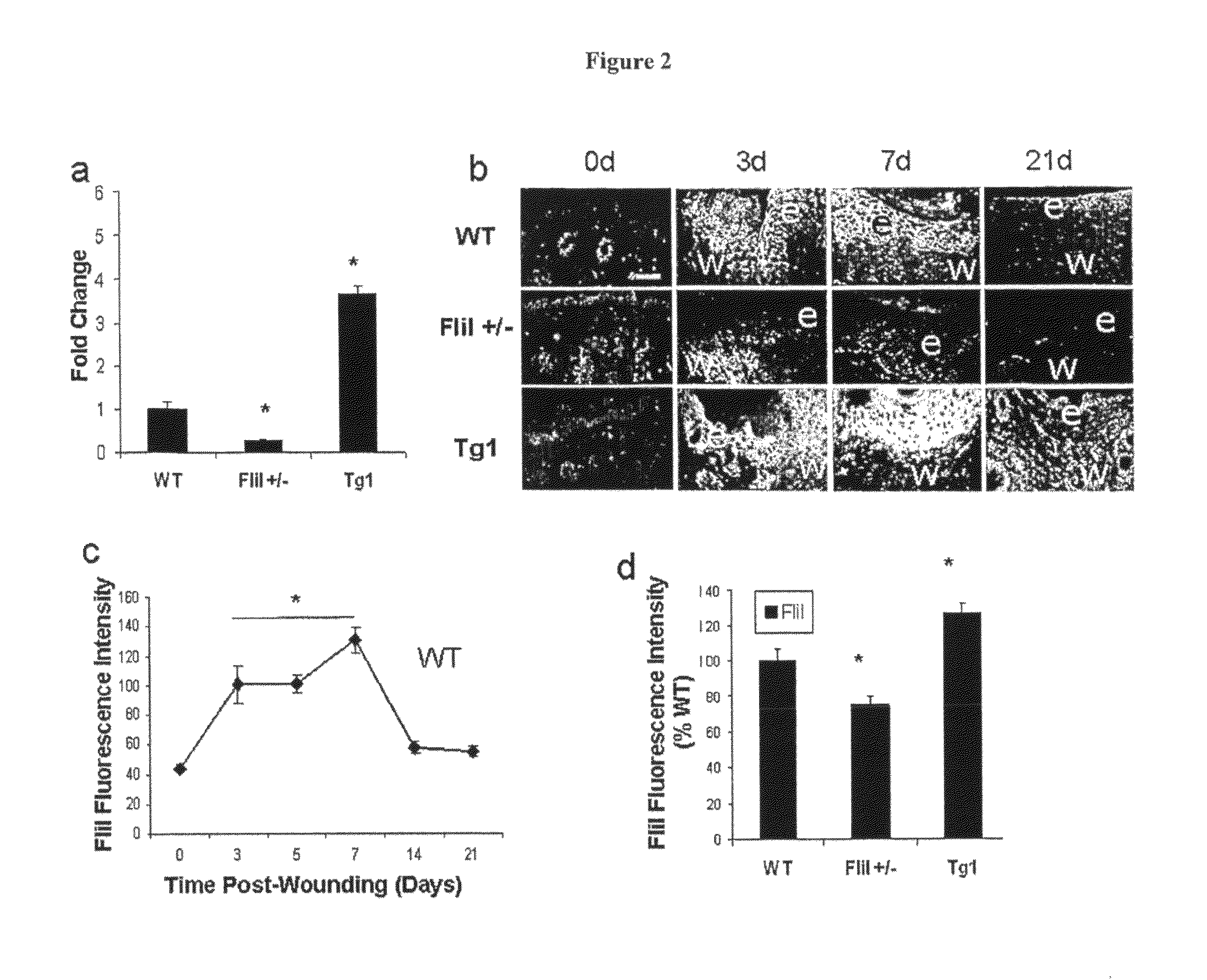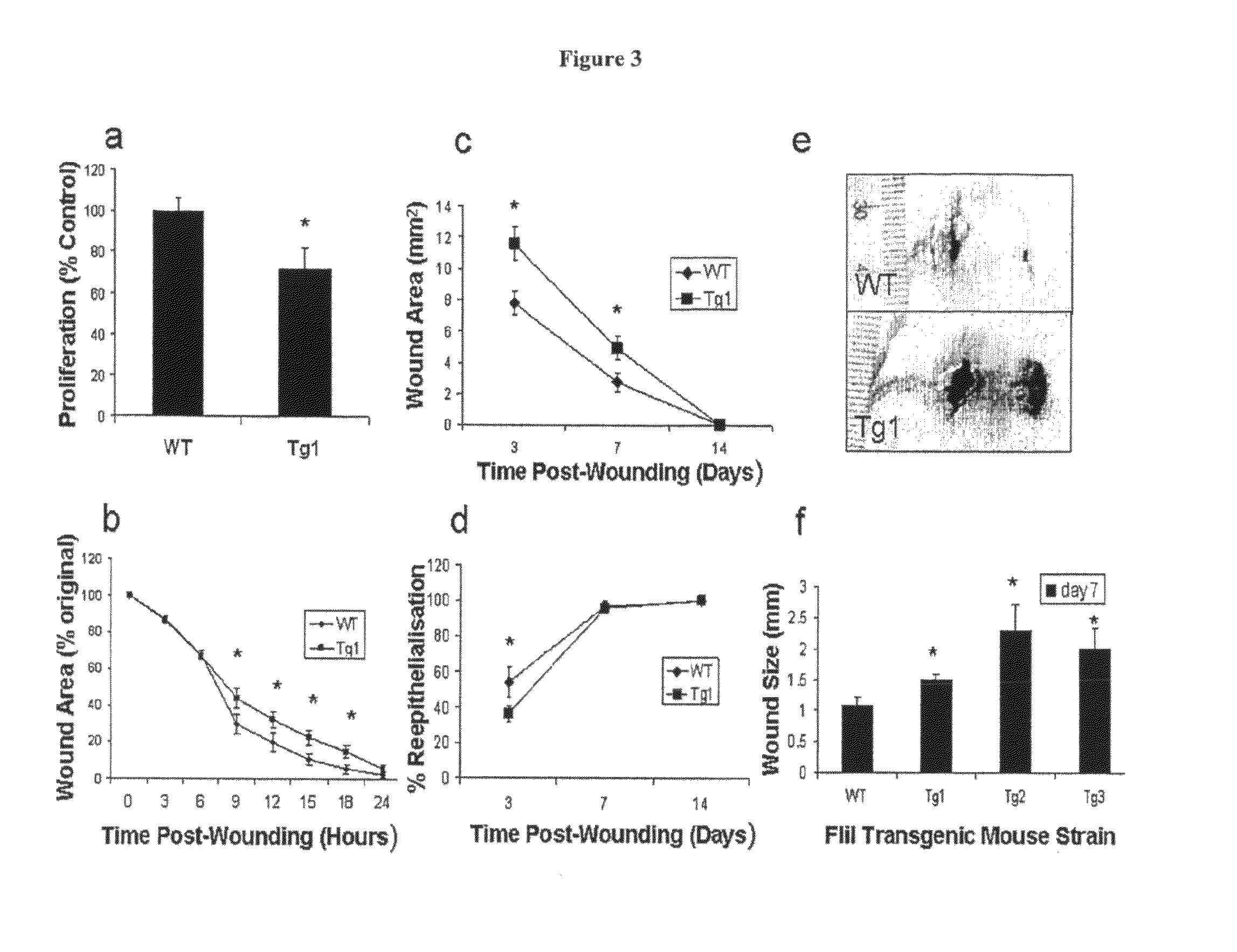Methods and compositions for modulating wound repair
a wound and composition technology, applied in the direction of antibody medical ingredients, peptide/protein ingredients, peptide sources, etc., can solve the problems of high scar formation, unreliable and unpredictable treatment, empirical treatment, etc., to prevent and/or treat fibrotic disorders, and improve wound healing and scar formation
- Summary
- Abstract
- Description
- Claims
- Application Information
AI Technical Summary
Benefits of technology
Problems solved by technology
Method used
Image
Examples
example 1
Antibodies
[0244]Mouse monoclonal anti-FliI antibody (sc-21716) and rabbit anti-TGF-β1 polyclonal antibody (se-146) were obtained from Santa Cruz Biotechnology (CA, USA) whilst goat anti TGF-βs3 was obtained from R&D Systems (MN, USA). Rabbit polyclonal anti-Collagen I was obtained from Monosan (Uden, The Netherlands). FITC-conjugated phalloidin was purchased from Sigma-Aldrich (Sydney, Australia). Affinity purified rabbit anti-FliL antibodies raised against the leucine rich repeat domain of the FliI protein has been previously described (Davy, D. A. et al. 2001. The flightless I protein colocalizes with actin- and microtubule-based structures in motile Swiss 3T3 fibroblasts: evidence for the involvement of PI 3-kinase and Ras-related small GTPases. J Cell Sci 114:549-562).
example 2
FliI Deficient+ / − and Transgenic Mice
[0245]All studies were performed in mice with the BALB / c background. FliI deficient heterozygous null mice (FliI+ / −) and mice carrying the complete human FliI gene on a cosmid transgene were as described previously (Campbell, H. D. et al. 2002. Fliih, a gelsolin-related cytoskeletal regulator essential for early mammalian embryonic development. Mol Cell Biol 22:3518-3526).
[0246]Heterozygous transgenic mice (Tg1) were made by crossing FliI+ / + with cosmid transgene+ / −. These transgenic mice were intercrossed to obtain animals homozygous for the transgene (Tg2; FliI+ / +, cosmid transgene+ / +). An independent transgenic line (Tg3) was made by excising the FliI gene from cosmid c110H8 (Campbell, H. D. et al. 2002. Fliih, a gelsolin-related cytoskeletal regulator essential for early mammalian embryonic development. Mol Cell Biol 22:3518-3526) as a 17.8 kb BspHI fragment. This fragment contains ˜4 kb of 5′-flanking sequence extending into the 5′ end of th...
example 3
Murine Surgical Techniques
[0247]FliI transgenic mice (Tg1-3; female 16-20 weeks old) and wild-type sex and age-matched litter mates were wounded using the same protocol previously described in (Cowin, A. J. et al. 2006. Wound Healing Is Defective in Mice Lacking Tetraspanin CD151. J Invest Dermatol.). Briefly, two equidistant 1 cm full thickness incisions were made through the skin and left to heal by secondary intention. Digital photographs were taken of the wounds at 0, 3, 7, 14 and 21 days post-wounding. A ruler was aligned next to the wound to allow direct wound area and wound gape (mid-point of the 1 cm incision) measurements to be made. Wounds were harvested at 3, 7, 14 and 21 days and were bisected. One half was fixed in 10% buffered formalin and processed so that the midpoint of the wound was sectioned and compared between groups. The other half was microdissected to remove any contaminating normal, unwounded skin and snap frozen in liquid nitrogen for RNA and protein extrac...
PUM
| Property | Measurement | Unit |
|---|---|---|
| thickness | aaaaa | aaaaa |
| pH | aaaaa | aaaaa |
| pH | aaaaa | aaaaa |
Abstract
Description
Claims
Application Information
 Login to View More
Login to View More - R&D
- Intellectual Property
- Life Sciences
- Materials
- Tech Scout
- Unparalleled Data Quality
- Higher Quality Content
- 60% Fewer Hallucinations
Browse by: Latest US Patents, China's latest patents, Technical Efficacy Thesaurus, Application Domain, Technology Topic, Popular Technical Reports.
© 2025 PatSnap. All rights reserved.Legal|Privacy policy|Modern Slavery Act Transparency Statement|Sitemap|About US| Contact US: help@patsnap.com



